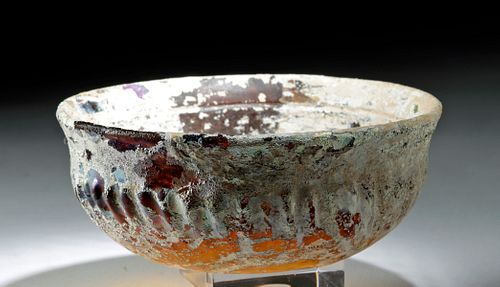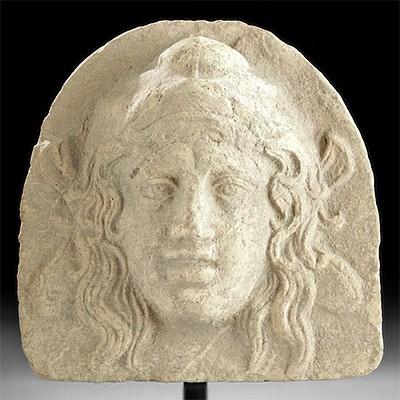Roman Glass Bowl - Pearlescent Iridescence
Lot 64
About Seller
Artemis Gallery
686 S Taylor Ave, Ste 106
Louisville, CO 80027
United States
Selling antiquities, ancient and ethnographic art online since 1993, Artemis Gallery specializes in Classical Antiquities (Egyptian, Greek, Roman, Near Eastern), Asian, Pre-Columbian, African / Tribal / Oceanographic art. Our extensive inventory includes pottery, stone, metal, wood, glass and textil...Read more
Categories
Estimate:
$1,300 - $1,950
Absentee vs Live bid
Two ways to bid:
- Leave a max absentee bid and the platform will bid on your behalf up to your maximum bid during the live auction.
- Bid live during the auction and your bids will be submitted real-time to the auctioneer.
Bid Increments
| Price | Bid Increment |
|---|---|
| $0 | $25 |
| $300 | $50 |
| $1,000 | $100 |
| $2,000 | $250 |
| $5,000 | $500 |
| $10,000 | $1,000 |
| $20,000 | $2,500 |
| $50,000 | $5,000 |
| $100,000 | $10,000 |
| $200,000 | $20,000 |
About Auction
By Artemis Gallery
Feb 27, 2020
Set Reminder
2020-02-27 10:00:00
2020-02-27 10:00:00
America/New_York
Bidsquare
Bidsquare : VARIETY SALE | Antiquities & Ethnographic Art
https://www.bidsquare.com/auctions/artemis-gallery/variety-sale-antiquities-ethnographic-art-4920
Around the world & back in time - be amazed at the treasures you will find. Antiquities from Egypt, Greece, Italy and the Near East, Asian, Pre-Columbian, African / Tribal / Oceanic, Native American, Spanish Colonial, Russian Icons, Fine Art, much more! Artemis Gallery info@artemisgallery.com
Around the world & back in time - be amazed at the treasures you will find. Antiquities from Egypt, Greece, Italy and the Near East, Asian, Pre-Columbian, African / Tribal / Oceanic, Native American, Spanish Colonial, Russian Icons, Fine Art, much more! Artemis Gallery info@artemisgallery.com
- Lot Description
Roman, Imperial period, ca. 1st to 3rd century CE. A glass bowl with a ribbed exterior, a slightly flared rim, and a gently concave base. Time has made this piece absolutely gorgeous, coating much of its translucent brown surface with a thin, pearlescent and rainbow iridescence. A narrow groove on the interior demarcates the mouth of the vessel. Size: 5.5" W x 2.25" H (14 cm x 5.7 cm)
Most scholars agree, Roman glass was of the highest quality - both aesthetically and technically - among the ancients. While glass making had been practiced for centuries, glass blowing was invented in the Roman-controlled Holy Land in the 1st century BCE. This innovative technology revolutionized the artform. We can appreciate such a wide variety of forms and shapes, because the medium of glass has unique physical properties that make for so many more possibilities which would eventually replace a wide variety of pottery and metal wares in the ancient world. Roman glassmakers reached incredible artistic heights with both free-blown vessels and mold blown forms and decorations and were traded far beyond the Roman Empire. Roman glass vessels have been found in Scandinavia, India, and in Han Dynasty tombs in China.
Provenance: ex-Martin Wunsch collection, New York, USA, acquired in the 1980s
All items legal to buy/sell under U.S. Statute covering cultural patrimony Code 2600, CHAPTER 14, and are guaranteed to be as described or your money back.
A Certificate of Authenticity will accompany all winning bids.
We ship worldwide and handle all shipping in-house for your convenience.
#135259One side of the bowl has been repaired from what looks like four or five pieces. Repairs are well done and difficult to see. Brilliant pearlescent and rainbow iridescent patina covering much of the interior and exterior surface.Condition
- Shipping Info
-
All shipping is handled in-house for your convenience. Your invoice from Artemis Gallery will include shipping calculation instructions. If in doubt, please inquire BEFORE bidding for estimated shipping costs for individual items.
-
- Buyer's Premium



 EUR
EUR CAD
CAD AUD
AUD GBP
GBP MXN
MXN HKD
HKD CNY
CNY MYR
MYR SEK
SEK SGD
SGD CHF
CHF THB
THB
















